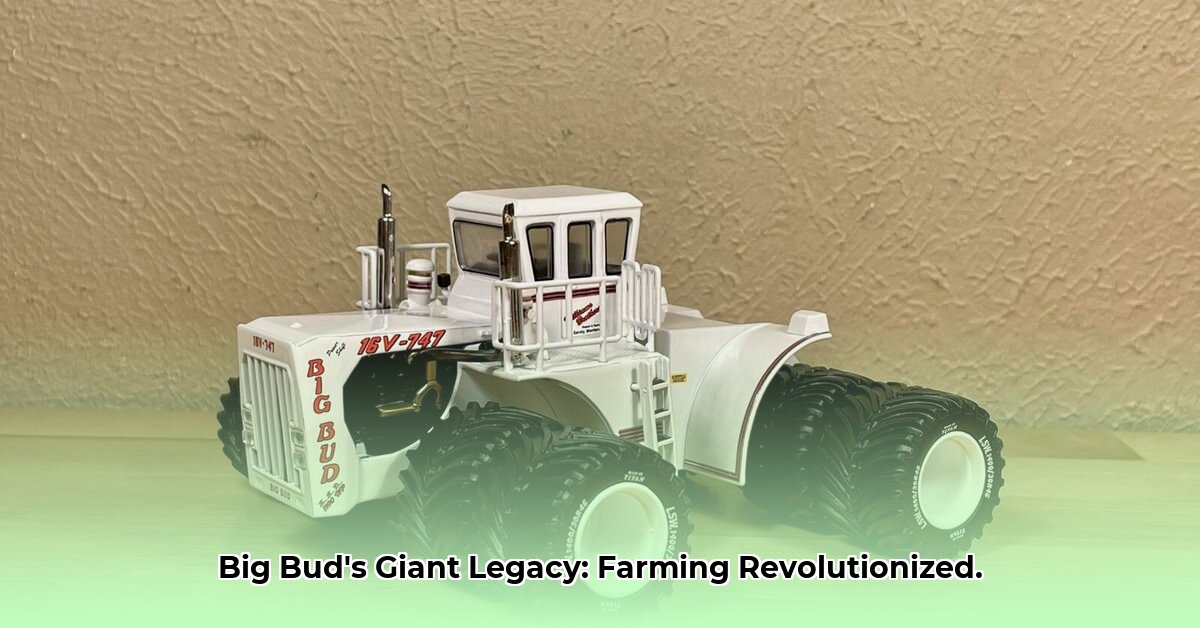
The Big Bud tractor. The name alone evokes images of immense size and unparalleled power. More than just a machine, it represents a pivotal moment in agricultural history and continues to fascinate, even inspiring a dedicated market for toy replicas. For more on Big Bud toys, check out this website. This article delves into the Big Bud's legacy, exploring its technological advancements, operational impact, cultural significance, and enduring influence on modern farming.
The Giant's Genesis: A Revolution in Efficiency
The 1970s presented a challenge to farmers: vast fields demanded increasingly efficient harvesting methods. Existing machinery simply couldn't keep pace. The answer? The Big Bud, a colossal leap forward in agricultural technology. This wasn't a minor upgrade; it was a monumental shift. Imagine a tractor nearly 27 feet long, 20 feet wide, and 14 feet tall—a true giant among machines. Its creation stemmed directly from the urgent need for larger, more efficient equipment to handle the expanding scale of agricultural operations.
A Technological Marvel: Under the Hood
The Big Bud's impressive power came from its engine, initially boasting 760 horsepower, later upgraded to an astounding 1100 horsepower. This translated to exceptional productivity; the machine could cultivate over an acre of land per minute, far exceeding the capabilities of previous tractors. This efficiency revolutionized farming practices. Key specifications highlight its impressive capabilities:
| Feature | Specification | Impact |
|---|---|---|
| Engine Horsepower | 760-1100 horsepower (equivalent to multiple smaller engines) | Unmatched power for unprecedented speed and efficiency in large-scale farming |
| Length | Approximately 27 feet (longer than most city buses) | Allowed for covering massive areas in significantly less time |
| Width | Approximately 20 feet (wider than many roads) | Optimized row spacing for large-scale planting and harvesting |
| Tire Size | Extremely large (precise dimensions vary) | Superior traction, minimized soil compaction |
| Fuel Consumption | Extremely high (Specific figures require further research) | Significant environmental consideration in modern context |
Transforming Farming: Before and After
Before the Big Bud's arrival, large-scale farming was labor-intensive and time-consuming. The Big Bud drastically reduced labor needs and time requirements, increasing efficiency across the board. However, its size presented challenges: maneuverability in smaller fields was limited, and maintenance costs were considerable. Despite these drawbacks, the Big Bud's overall positive impact on farming methods is undeniable; it marked a significant turning point. How did it change the daily work of a farmer, and what were the immediate impacts? That's a critical part of understanding its overall legacy.
Beyond the Fields: An Enduring Cultural Icon
The Big Bud's influence transcends the agricultural realm. It became a symbol of American ingenuity and technological prowess. This iconic status is reflected in the enduring popularity of Big Bud toy replicas, sought after by collectors and enthusiasts alike. These miniatures aren't mere playthings; they're tangible representations of a significant piece of agricultural history. Furthermore, museums proudly display original Big Bud tractors, cementing their place in agricultural heritage. Why this lasting cultural appeal? The answer likely lies in its symbolic power, embodying scale, efficiency, and a bygone era of farming.
The Big Bud's Enduring Legacy: A Blueprint for the Future?
While the Big Bud's technology is now outdated, its innovative engineering principles continue to influence the design of modern agricultural equipment. Although its specific design may be considered obsolete, its fundamental aim – creating powerful and efficient machinery – remains a key objective in the ongoing evolution of farming techniques. Preserving these historic machines is crucial for understanding the progress made in agriculture and the challenges of the future.
The Big Bud's Future & Ongoing Debates: Sustainability and the Next Generation
The Big Bud legacy demands a discussion about sustainability. Its substantial fuel consumption raises critical questions about the environmental impact of large-scale farming. Some experts argue that the Big Bud's story serves as a cautionary tale, highlighting the need for more eco-friendly farming methods. This challenge drives innovation toward sustainable technology, shaping the future of agricultural machinery and minimizing the environmental footprint of food production. What innovations are being made? Do they directly stem from trying to improve on the positives of the Big Bud while minimizing its negatives? These are important questions for anyone interested in the future of farming.
Comparing Big Bud Fuel Efficiency to Modern Alternatives: A Complex Equation
The Big Bud's fuel consumption was substantial. Comparing it to modern tractors requires a nuanced approach. While modern tractors are significantly more fuel-efficient, a direct comparison is complex. Factors such as engine size, transmission type, implements used, operating conditions, operator skill, and maintenance all play crucial roles. Direct numerical comparisons, therefore, are difficult to make definitively. This highlights the need to appreciate progress in efficiency while considering the historical context.